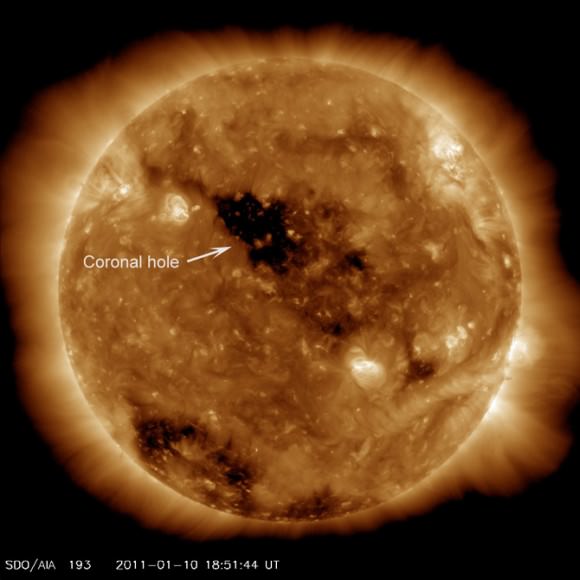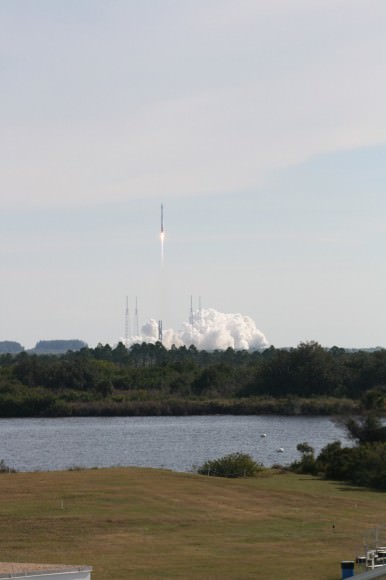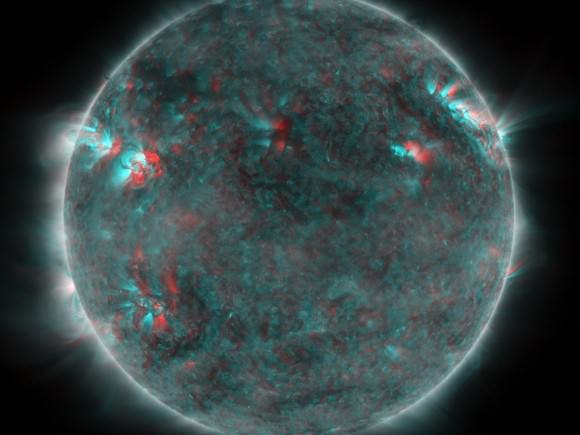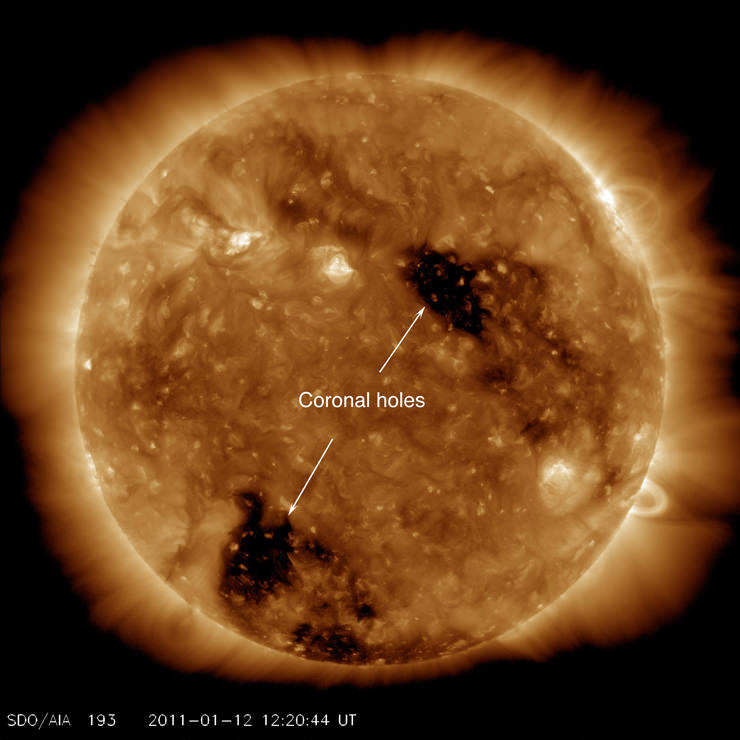[/caption]
A pair of coronal holes on the Sun newly imaged by NASA’s flagship solar probe, the Solar Dynamics Observatory (SDO) may cause auroral activity here on Earth soon.
The pair of holes were captured in images taken from Jan 9-12, 2011 by SDO’s AIA instrument in the extreme untraviolet (UV). The images – shown above and below – were also made into a cool timelapse video (shown below) of the rotating sun and were released by NASA as “SDO Pick of the Week” for Jan. 14, 2011.
SDO research results on the solar corona are featured as the cover photo and story for the current issue of Science magazine on Jan. 7, 2011. Updated

Multiwavelength extreme ultraviolet image of the Sun taken by the Solar Dynamics Observatory's Atmospheric Imaging Assembly. Colors represent different gas temperatures: ~800,000 kelvin (K) (blue), ~1.3 million K (green), and ~2 million K (red). New observations reveal a link between hot plasma and jets propelled upward from the region immediately above the Sun's surface and help explain why the Sun's outer atmosphere, or corona, is much hotter than its surface. Image: NASA/Solar Dynamics Observatory/Atmospheric Imaging Assembly (AIA)
Click to enlarge all images
Coronal holes on the sun’s surface are the source of open magnetic field lines and are areas from which high-speed solar wind particles stream out into space. The fast solar wind travels at approximately 800 km/s (about 1.8 million mph). After traveling through space for a few days the particles will impact the Earth and may spark the formation of some auroral activity for lucky spectators.
The two holes developed over several days. In a video here, one hole is above the suns equator and the other is below. According to a NASA press release, the coronal holes appear dark at the extreme UV wavelength of 193 Angstroms because there is just less of the material – ionized iron- that is being imaged.
2 D Video: A Hole in the Sun’s Corona
Caption: This timelapse video shows a coronal hole, as captured in ultraviolet light by NASA’s Solar Dynamics Observatory around Jan. 10, 2011. Coronal holes are areas of the sun’s surface that are the source of open magnetic field lines that head way out into space. They are also the source regions of the fast solar wind, which “blows” at a relatively steady clip of 1.8 million mph. (No audio). Credit: NASA
3 D Video: Coronal holes from STEREO
Check out this 3 D movie of a coronal hole snapped by NASA’s twin STEREO solar probes orbiting the sun. You’ll need to pull out your red-cyan 3 D anaglyph glasses. First, watch the short movie with you 3 D glasses. Then, I suggest to pause the movie at several intervals for a longer look. Remember – its red on the left eye.
View more 3 D from SDO below. And enjoy more 3 D space imagery here – at a big Martian crater through the eyes of the Opportunity rover.
Caption: This STEREO image features an active region and a coronal hole. The hole is the large dark spot in the middle of the sun. Coronal holes are the source of solar wind and a generator for space weather activity. Credit: NASA
More at this NASA press release
SDO roared to space on February 11, 2010 atop a powerful Atlas V rocket from Cape Canaveral Air Force Station in Florida. Launch photo below.
The billion dollar probe is the “crown jewel” in NASA’s solar fleet and will soon celebrate its first anniversary in space. SDO’s mission is to explore the Sun and its complex interior mechanisms in unprecedented detail. It is equipped with three science instruments (HMI, AIA, and EVE)



This 3 D image was created by combined two images that were taken in one extreme UV wavelength about 8 hours apart on June 25, 2010. The Sun's rotation created enough of a perspective change for this to work. Although the SDO mission cannot produce true 3D images of the Sun like STEREO, 3D solar images can still be made from SDO images. Credit: NASA/SDO


I thought it interesting that although the Sun is so, so bright, the holes are so dark.
Thanks for the reference. Unfortunately the article features solar flare line emission between 6 A and 25A, whereas the new video of coronal holes is at 193-Angstroms. A look at the SDO AIA instrument page shows that the 193Å channel is for measuring Fe XII, Fe XXIV in the corona and in hot flare plasma.
Sorry for the mix up. The range here is confusing as it is sometimes in X-ray, sometimes in XUV. Still, it gives you the ideas of the sort of “energy state(s) of ionized iron produces this emission.”
You should be able to find more on this yourself, at http://adsabs.harvard.edu/physics_service.html
The darkness of the holes are an illusion. The image was “extreme UV wavelength of 193 Angstroms”, and that wavelength cannot be seen by the human eye. For our eyes, the Sun would be completely dark at 19.4nm.
Also ” extreme untraviolet (UV)” is commonly abbreviated as XUV not UV, as given throughout the article.
Note: The SI units are in nanometres NOT angstroms, so the wavelength is 19.4 nm.
Thanks for the explanations. I assumed that no matter what the wavelength, that the intense radiation would still be strong enough to illuminate other areas of the Sun. Does anyone know:
If the 193-angstrom UV filter has a significant bandwidth?
Which energy state(s) of ionized iron produces this emission? I could find very little, except an un-annoted spectrum here.
@iantresman – the image has been captured in such a way that isolates the gases / plasma in the sun’s atmosphere – so where the image appears dark, it’s simply indicating a lack of atmosphere.
i.e. this image doesn’t mean to suggest that the sun’s surface is dark – despite what your eyes are trying to tell you!
😉
It is currently known that 0.07% of the corona is Na X, Sodium will nine electrons removed, and > 0.05% of Cl VII, with six electrons removed. The largest amount of energetic ‘metals’ is FeXX and Fe XXIII/IV lines, though all of the X-ray lines in the corona are from Fe IX to XXIII.
Ion species of Fe XVIII, Fe XXIV, Fe XXI are normally generated during CME events, whose emission lines correspond to one to twelve million kelvins.
Much of the work was done with a spectrometer (using the Extreme UV Spectroheliograph and the grazing incident X-Ray spectroheliograph) in the late-1960’s on the Orbiting Solar Observatory No. 5 (OSO-5) satellite. (1969 to 1975) They found X-ray activity was tied up with the variable strength of the magnetic field on the photosphere.
It is best to read Neupert et.al. “Solar Flare Line Emission Between 6 A and 25A” at the ADS at the link http://adsabs.harvard.edu/abs/1973SoPh…31..171N
(The Transitions start from pg.181., which from your chemistry background will be easy to understand.)
“Does anyone know:
If the 193-angstrom UV filter has a significant bandwidth?”
I don’t know if this may be helpful, but this link ( http://aia.lmsal.com/public/CSR.htm#tth_sEc3 ) gives reflectivities and transmissivities of the AIA EUV mirrors (Fig A10) while (Fig 11A) gives (expected) response functions of the EUV channels for AIA, including the 194 A channel.
@Jon, thanks for the link, which is also vague about the bandwidth of the 193-angstrom UV filter. Strictly speaking, this is the name of the filter, and does not necessarily imply that it detects only at 193-A. And whatever the bandwidth, there is no indication whether 193-A is the lower, midpoint, or upper point in the range.
I guess that since it can detect Fe XII, and Fe XXIV. emissions, then its range must include 195.12 Å (Fe XII) and 192.1 (Fe XXIV) transitions, which suggests that 193-A is more of a midpoint.
Thanks for the slap. it will not happen again.